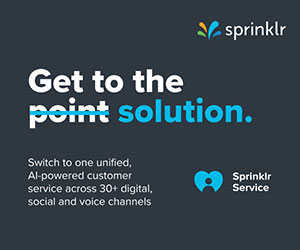Kumaran Shanmuhan of Jacada shares his top five speech analytics use cases to automate the call centre.
It’s that time of year call centre leaders dread: budget planning. Seemingly without fail, call centres are asked to reduce costs to meet next year’s budget while still maintaining high levels of service, productivity and responsiveness. It’s a tall order, to be sure, but not an impossible one.
Contact centre technology can go a long way toward streamlining and improving everyday processes, helping customer support teams lower their operating expenses.
According to McKinsey & Company, organizations that use the latest tech to boost customer experience can reduce their customer service costs as much as 40%.
That doesn’t necessarily mean call centres need to make a major investment to start realizing those cost-saving benefits. Process changes and enhancements can have a significant impact on your bottom line and quality of service – if you know where to look.
Speech analytics is nothing new to customer service leaders who have used it to dig through call records to better understand where changes need to be made to reduce costs and customer churn while enhancing the customer experience.
What’s new? Recent advances in real-time speech analytics have made the technology truly actionable and cost effective as well.
The pandemic has accentuated the need for simplicity, automation and agent assistance in work-from-home call centres.
The combined forces have created a realm of automation opportunities, which can completely revamp the call centre from top to bottom. So, let’s dig in.
1. Identify Opportunities to Boost Self-Service Adoption
Many consumers prefer to speak to an agent directly rather than search out other means to answer their questions or troubleshoot an issue.
However, insisting on live agent support all the time can be counterproductive when calling a contact centre isn’t the fastest or most effective way to address an issue.
As more people clog phone lines, wait times can balloon, frustrating callers and hurting the customer experience.
Customers who want to complete relatively simple tasks like updating account information, confirming reservations or checking order statuses are likely better off using self-service tools and digital platforms. Mobile applications, AI-enabled chatbots and conversational IVR all offer alternative ways to provide customer service without requiring a live agent.
Speech analytics tools access call logs to provide insights into customer intent and help organizations better understand why people contact their call centres.
If an abundance of customers consistently reach out to resolve straightforward issues or requests such as those listed earlier, then that’s a good sign that more self-service tools are needed.
Also, it’s possible that businesses have the right tools in place, but people just aren’t taking advantage of them.
Deeper analysis may show that there’s a breakdown in the customer support process or communications network that prevents companies from raising awareness about available self-service options.
Identifying the problem is the first step toward correcting it, and with speech analytics, call centre leaders can glean the insights needed to better understand customer needs and direct callers to more appropriate support channels. That means fewer callers will be stuck on hold, waiting for an agent to get around to them.
2. Ease Channel Switching With Multimodal Customer Assistants
When the world went into lockdown a few months ago, customer interaction patterns went completely off the rails.
No power law or Erlang calculator could have offered reasonable call centre capacity plans to moderate wait times for anxious callers.
Businesses pulled all stops to deal with high call volumes, with IT staff and executives answering calls.
Every bank, telco and utility company had signs on their websites warning customers of long wait times.
Many took the proactive approach of offering callers stuck in the phone menu a link to the website. This concept of recommending an easier and more effective self-service option is often referred to as channel switching.
What makes the other option easier and more effective is certainly a matter of great debate, and the subject of a different blog post.
Visual IVR interactions that guide the caller to a digital asset on their smartphone are much more effective in boosting self-service rates and NPS scores when the call remains open as the caller navigates the digital asset.
Real-time speech to intent analytics (part of conversational AI) is used to understand points of friction as the caller goes from voice to a visual and multimodal experience.
With an ability to engage the caller through visual and voice modalities at the same time, you can get more done and encourage the caller to use digital tools by showing them how easy and effective self-service really is.
3. Identify Customers Who Need Live Assistance
For the last several years, companies that have invested in their contact centres have done so largely in order to improve the customer experience.
Deloitte’s 2019 Global Contact Center Survey found that 85% of respondents listed customer experience as the main driver behind their call centre investments and enhancements.
To provide customers with the best experience possible, businesses need to understand the strengths of their different support channels and use them accordingly.
Requiring customers to call an agent just to confirm a reservation is needlessly complicated and time-consuming for both caller and representative.
Digital platforms and self-service tools are better suited to manage those requests than a contact centre agent.
On the other hand, there are jobs that do require a personal touch. Customers who want to vent about a problem or need more hands-on support are always going to turn to call centre representatives for guidance or listen to their frustrations.
Chatbots aren’t quite sophisticated enough to offer that personal level of service.
Speech analytics can help call centre leaders identify the types of interactions that require direct agent support, redirecting other requests to platforms that are just as capable at resolving issues without flooding the centre with calls.
Conversely, they can monitor those other channels for statements that might indicate more direct intervention is necessary, preemptively forwarding users to live agents instead of wading through menus, screens and information forms.
4. Match the Customer With the Right Agent
Call centres can even make better use of their personnel with speech analytics platforms. These tools can identify phrases indicating a customer is frustrated and wants to vent about a problem they’re experiencing.
The system then redirects the caller to an agent who has the knowledge, experience and temperament to manage angry customers and find a satisfactory solution.
5. Identify Opportunities to Assist Agents in Real Time
The job of a call centre agent is often difficult, especially if representatives are constantly inundated with requests, questions or complaints that cannot be easily addressed.
Employee burnout and churn are very real concerns for contact centres, and if left unchecked, will only place further strain on other staff members.
The Cisco Contact Center Global Survey 2020 identified agent turnover as one of top five challenges facing call centres today, with 73% of respondents listing it as a major concern.
Speech analytics can help ease the burden placed on representatives’ shoulders, giving them the time and bandwidth to do their jobs well without becoming overwhelmed.
With the latest advances in speech analytics and natural language processing, call centre leaders can now leverage speech analytics in real time to identify opportunities to assist the agent and automate some of their tasks.
As the customer and the agent start talking, the audio streams are processed in real time to understand the customer’s intent and pick up on the customer’s and agent’s emotions.
Magic happens when real-time insights from the call are actioned by an assistant on the agent desktop:
- Present step-by-step guided workflows to help the agent on the identified customer intent, driving process compliance and reduced training cycles.
- Nudge the agent to take an alternative course of action based on detours the conversation might call for.
- Automate manual tasks using systems integration and robotic desktop automation to reduce hold time and average handling time.
- Generate automated call summaries to consistently document customer interactions and reduce after-call work time.

Kumaran Shanmuhan
Speech analytics presents numerous opportunities to improve different aspects of the call centre, enhancing customer experience, driving sales, reducing customer attrition and boosting employee satisfaction in the process.
That said, you need to proceed with a data-driven mindset around prioritizing and executing on automation opportunities.
Author: Guest Author
Published On: 20th Aug 2020 - Last modified: 8th Aug 2022
Read more about - Archived Content, Jacada




























